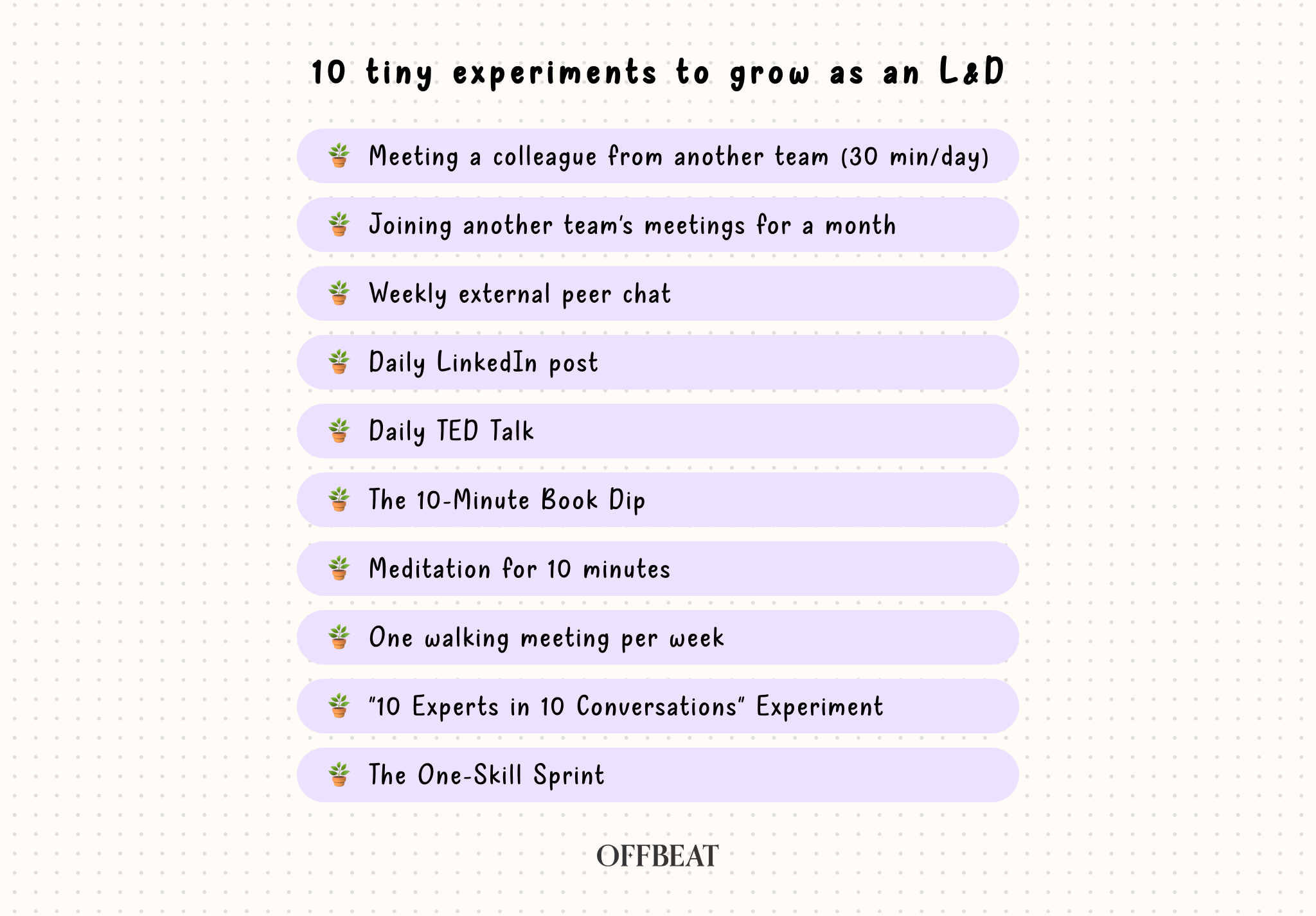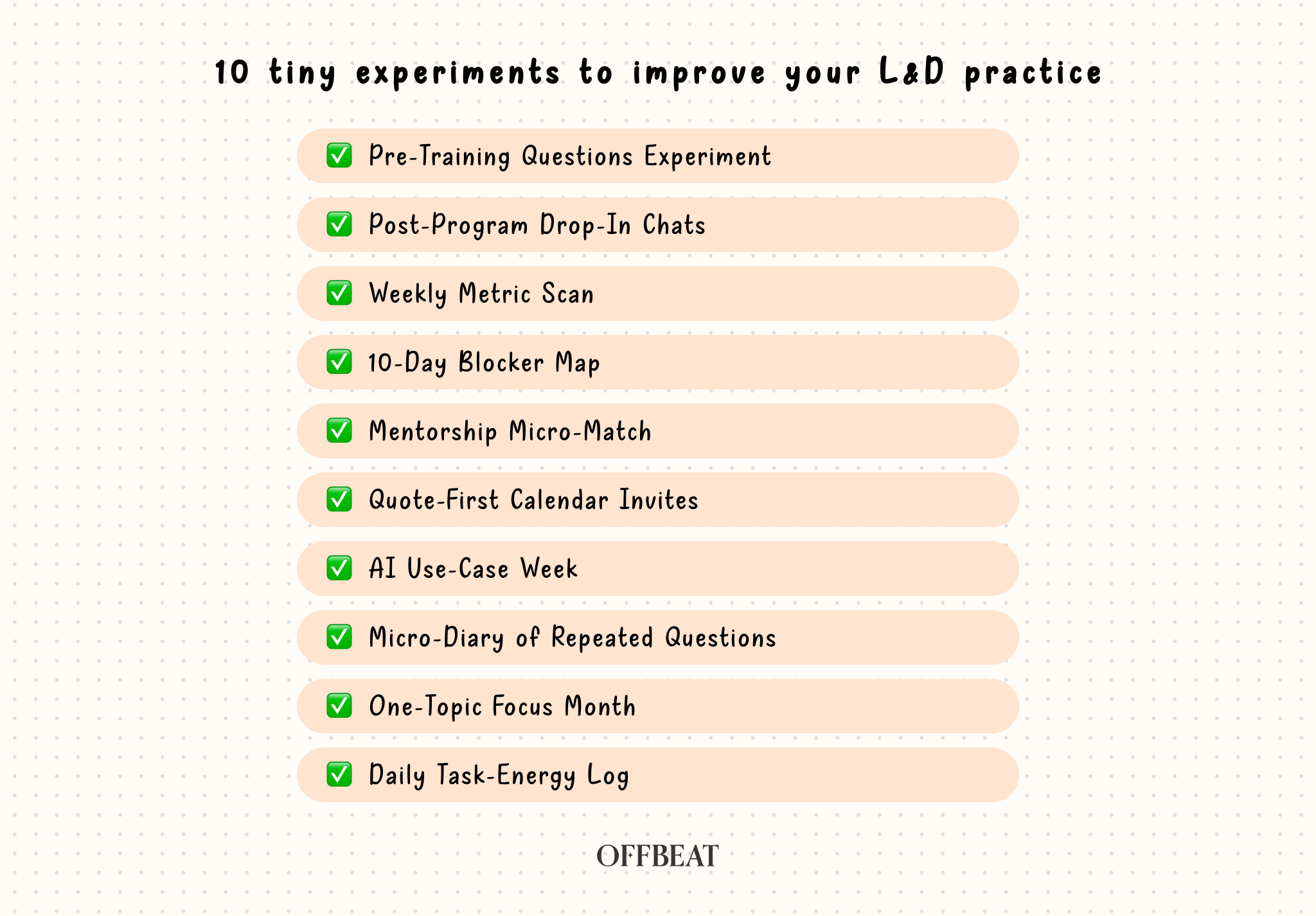Ever since I discovered Anne-Laure Le Cunff’s idea of tiny experiments, I’ve been a little bit obsessed. The kind of obsession where suddenly every challenge becomes a “hmm… what if I tried this tiny thing for a week and just saw what happens?”
For those of us in L&D, especially the brave souls working alone or in tiny teams, this mindset is magic. We carry so much responsibility: build the leadership pipeline, redesign onboarding, drive a learning culture, measure ROI, and keep everyone engaged. It’s a lot.
Tiny experiments offer relief. They replace pressure with curiosity. Instead of committing to big initiatives with uncertain outcomes, we get to run small tests, gather insights, and adjust based on evidence, not hope.
Before we dive into the list of experiments, here are three things worth knowing.
What tiny experiments are
Tiny experiments are small, low-stakes tests that help you learn something about your learners, your culture, or your systems. They’re time-boxed, specific, and intentionally light to run.
They’re not meant to change the whole organization overnight. They’re meant to help you discover what works here, with your people, in your context.
Tiny steps. Real signals. Quick learning.
How they differ from goals
A goal says: “I want to increase participation in L&D.”
A tiny experiment says: “If I send one short learning prompt each week for three weeks, participation in at least one activity will increase.”

Goals are big, often vague destinations. Tiny experiments are the small steps that teach you the path.
Goals give direction, experiments give information.
And for L&D professionals constantly navigating ambiguity, experiments create forward motion without the anxiety of “getting it right.”
PACT: the structure behind tiny experiments
Anne-Laure uses the PACT framework, which stands for:
- Purposeful — The action is connected to a meaningful hypothesis you want to test.
- Actionable — You know exactly what you will do; it’s concrete, not conceptual.
- Continuous — You repeat the same action consistently for a short period.
- Trackable — You can observe what happens and learn from the outputs.

A tiny experiment follows a simple format:
“I will [action] for [duration/ trials]”

No need for big plans or perfect conditions. Just a tiny, structured step into the unknown that makes uncertainty feel manageable.
10 tiny experiments to grow as an L&D
1. Meeting a colleague from another team (30 min/day)
I will meet one colleague from another team for 30 minutes each day for one week to test whether regular cross-team exposure helps me better understand how the organization really works.
Cross-functional conversations are one of the fastest ways to build real organizational intelligence, the kind that doesn’t show up in documentation or strategy decks. By meeting someone from another team every day, you begin to see how work truly flows, where friction lives, and what people actually care about.
This tiny experiment creates daily bursts of insight and helps L&D understand the system from multiple angles. It also builds relationships that make your work easier later: better buy-in, faster clarity, richer collaboration. And all of it comes from just 30 minutes a day.
2. Joining another team’s meetings for a month
I will attend one weekly meeting from a team I want to understand better for one month to test whether observing their rituals helps me identify real learning needs.
Watching a team in action is like lifting the curtain on how culture actually works. Their language, their decisions, the way they problem-solve, it all gives you insights you could never discover through formal needs analysis.
This experiment is immersive without being overwhelming: one meeting, once a week. Over a month, patterns begin to emerge. You’ll notice where skill gaps show up, how leaders behave, where people hesitate, and what’s valued. It’s quiet, observational learning at its best.
3. Weekly external peer chat
I will have one 20-minute chat per week with an external L&D peer for four weeks to test whether outside perspectives improve my thinking and expand my idea pool.
Talking to someone outside your organization is like opening a window and letting fresh air in. Suddenly you hear about different approaches, different constraints, different clever hacks. It frees you from the echo chamber of “how we do things here.”
Twenty minutes is all it takes. You'll gather new ideas, benchmark your challenges, and feel less alone in your L&D-of-one world. It’s simple, energizing, and surprisingly grounding.
4. Daily LinkedIn post
I will write one short LinkedIn post each day for one week to test whether public reflection helps me articulate what I’m learning more clearly.
Writing forces clarity. It helps you make sense of what you noticed, what surprised you, and what you want to remember. A daily LinkedIn post becomes a public learning diary, tiny, consistent, reflective.
You don’t need to write anything profound. Simply capturing one insight per day sharpens your thinking and builds your voice as an L&D professional. Plus, posting publicly creates gentle accountability to keep learning alive.
5. Daily TED Talk
I will watch one TED Talk per day on a selected topic for five days to test whether short, curated inspiration broadens my perspective.
TED Talks are bite-sized sparks, perfect for nudging your thinking in new directions without demanding huge time commitments. Five to twenty minutes a day can introduce you to concepts that reshape how you see leadership, creativity, AI, communication, or culture.
This experiment works because it’s structured and narrow. Choose one theme (like leadership or psychology) and let the algorithm guide you. You’ll notice your creativity waking up and your mental library expanding effortlessly.

6. The 10-Minute Book Dip
I will read for 10 minutes from any book in my professional library each day for one week to test whether small dips help me absorb more knowledge than long, irregular reading sessions.
We all have shelves full of books we meant to read, and yet life happens. The 10-minute dip removes the pressure of finishing books and replaces it with small, joyful encounters with ideas. Ten minutes is tiny, achievable, and surprisingly impactful.
It’s also a beautiful way to reconnect with physical books or Kindle highlights. You’ll revisit ideas you’d forgotten, discover passages you missed, and reignite your curiosity with no perfectionism attached.

7. Meditation for 10 minutes
I will meditate for 10 minutes each day for one week to test whether a simple mindfulness practice improves my clarity and emotional regulation at work.
L&D work is often emotionally heavy, supporting people, navigating politics, managing expectations. Meditation creates a small daily pause where you reset your nervous system and return to your work with more presence and less noise.
You don’t need an app, a playlist, or monk-like commitment. Ten minutes is enough to soften reactivity, sharpen listening, and make you more grounded as a facilitator, coach, or partner.
8. One walking meeting per week
I will turn one meeting per week into a walking meeting for six weeks to test whether movement helps me think more clearly and listen more deeply.
Walking meetings change the tone of conversations. They’re more relaxed, more human, and often more honest. Movement helps ideas flow and removes the intensity that sitting across a table can create.
This experiment is tiny but powerful. One walking meeting per week is easy to integrate, especially 1:1s. Over six weeks, you’ll likely notice better conversations, more energy, and even better relationship building.
9. “10 Experts in 10 Conversations” Experiment
I will speak with 10 experts for 30 minutes each over the next two weeks to test whether concentrated exposure accelerates my learning in a topic I want to master.
This is a fast-track learning sprint. Instead of slowly consuming content, you’re directly tapping into lived expertise. Ten short conversations expose you to diverse perspectives, practical stories, and nuanced thinking that no book or course can replicate.
Choose a topic you want to deepen, AI, leadership, facilitation, learning culture, and curate your expert list. By the end, you’ll feel like you’ve lived inside that domain for weeks, not days.






.svg)






.png)
.png)
.png)
.png)
